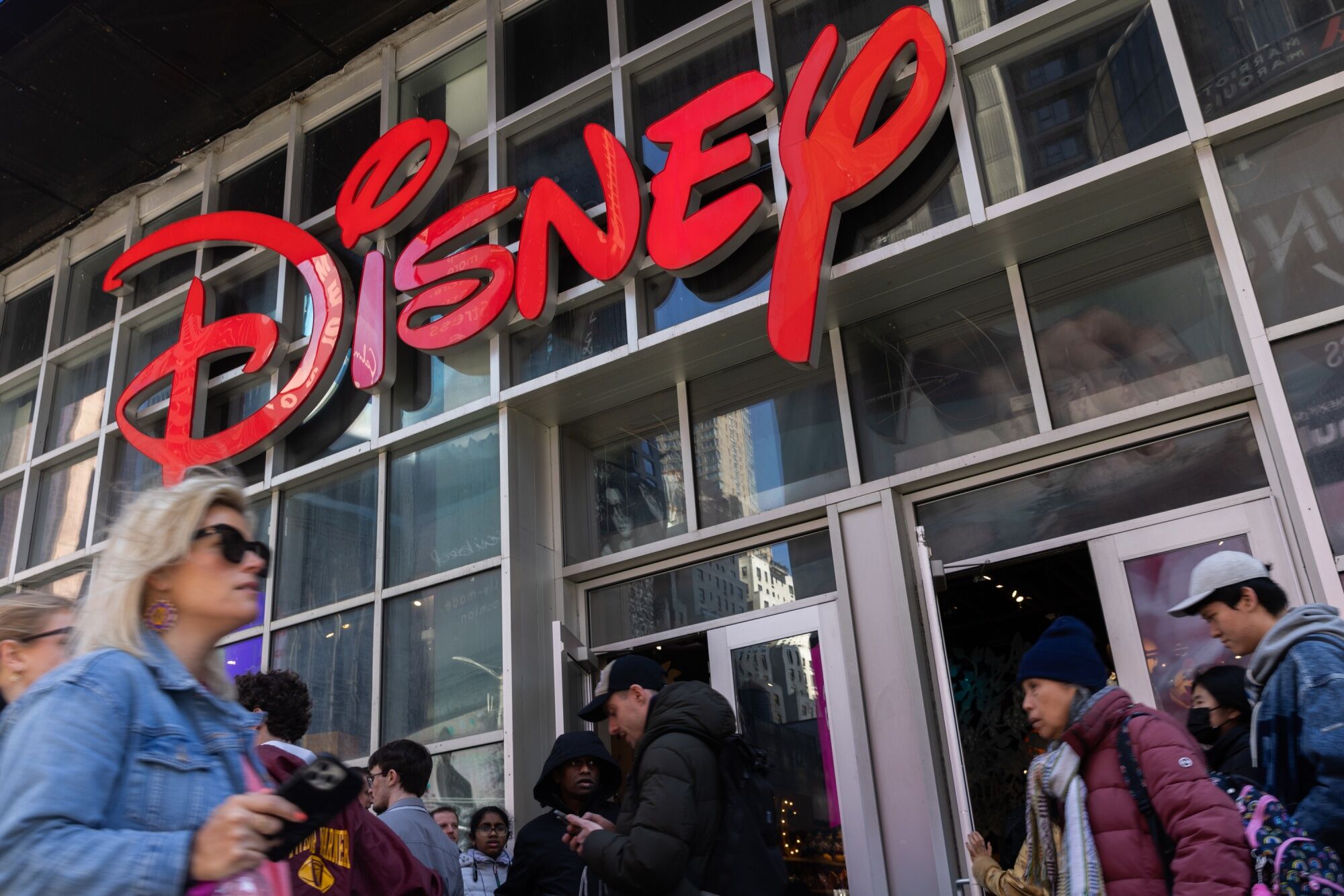
DISNEY SHARES DECLINE ON OUTLOOK DESPITE PATH TO PROFIT
(Bloomberg) -- Walt Disney Co. shares tumbled the most in a year and a half after the company reported a tepid outlook for growth in streaming subscribers in the current quarter and said that visits to parks are expected to moderate from peak post-Covid levels.
The media giant added more than 6 million subscribers in the second quarter to its core Disney+ streaming offering, which includes popular movies and the cartoon phenomenon Bluey. And losses in the direct-to-consumer streaming business, which includes ESPN+, narrowed to $18 million in the period from a loss of $659 million in the year earlier quarter.
But Chief Financial Officer Hugh Johnston said the company doesn’t expect to see core Disney+ subscriber growth in the current quarter and profitability in streaming will suffer due to due to additional expenses for cricket rights in India. Disney bought the India business in 2019 as part of its $71.3 billion acquisition of most of 21st Century Fox.
“We are pleased with the progress we’re making in streaming, although, as we said before, the path to long-term profitability is not a linear one,” Johnston said on a call with investors.
Shares of Disney closed down 9.5% to $105.39 Tuesday in New York, the worst single-day loss since November 2022. They had gained 29% this year through Monday.
Chief Executive Officer Bob Iger is in the midst of a years-long effort to reorganize Disney in the age of streaming, as the company loses subscribers to cable TV packages. Iger, who has been under pressure from activist investors, has aggressively cut costs, propped up ESPN and pumped new life into Disney’s studios after box-office misfires.
The company took an impairment charge of about $2 billion in the fiscal second quarter related to the India deal and to its traditional television networks. That nudged the company to a loss of $20 million after reporting net income of $1.27 billion a year earlier.
The company still expects its entire streaming business to be profitable in the fiscal fourth quarter.
Disney’s theme parks saw revenue increase 10% in the second quarter and the segment posted a 12% gain in operating income. But Johnston said he’s expecting little growth at parks in the current period, due to expenses such as a new cruise ship, before resuming growth later in the year.
What Bloomberg Intelligence Says:
“Disney commentary on a normalization of demand at the theme parks will weigh on sentiment even after the segment posted a solid 12% operating-income gain in fiscal 2Q.”
— Geetha Ranganathan, Bloomberg media analyst
Click here to read the report
Earnings in Disney’s theme-park division rose to $2.29 billion in the second quarter, driven by sharply higher results internationally, especially Hong Kong. Domestically the company’s cruise line and Disney World resort in Florida registered income growth, while California’s Disneyland saw weaker performance due to higher costs.
“While consumers continue to travel in record numbers and we are still seeing healthy demand, we are seeing some evidence of a global moderation from peak post-Covid travel,” Johnston said on the call.
Despite those setbacks, Disney issued an otherwise strong second-quarter report.
Earnings rose to $1.21 a share, excluding some items, in the period ended March 30, surpassing the $1.12 average of analysts’ estimates. Revenue in the first three months of the year increased 1.2% to $22.08 billion, compared with analysts’ forecast for $22.1 billion. Disney raised its guidance for full-year earnings growth to 25% from 20%.
The profit results marked the fourth straight quarter that Disney has beaten expectations in a sign that a turnaround is gaining momentum under Iger. Those gains helped Iger vanquish activist investor Nelson Peltz, who unsuccessfully campaigned for a board seat at Disney’s annual meeting in April.
The entertainment part of the company’s direct-to-consumer unit, which includes Disney+ and Hulu but not ESPN+, reported a profit of $47 million, as sales growth outpaced higher costs for programming and marketing.
“We got profitable earlier than we expected as the costs came in better than expected,” Johnston said in a telephone interview.
Disney had no new theatrical releases in the quarter, partly due to the twin strikes by writers and actors last year. Iger is seeking to reinvigorate that business by delaying some films to focus on quality. On the call, Iger said Disney will release only two Marvel movies a year, down from as many as four previously. The unit that includes the movie studio reported a loss of $18 million in the quarter on a 40% decline in sales.
Traditional TV networks, once a growth engine for the company, reported weaker results. Sales fell 8% to $2.77 billion in the unit that includes ABC, the Disney Channel and other TV networks. Profit fell 22% to $752 million due to lower ad sales and fewer cable subscribers.
In the sports segment, home to ESPN and related networks, sales rose 2% to $4.31 billion while profit fell 2% to $778 million, due in part to higher domestic rights fees.
(Updates with closing stock price in fifth paragraph.)
Most Read from Bloomberg
- Trump Judge Indefinitely Postpones Documents Case Trial
- One Out of Every 24 New York City Residents Is Now a Millionaire
- Israel Says a Cease-Fire Plan Backed by Hamas Falls Short
- Trump’s Private Life Exposed in Intimate Stormy Daniels Testimony
©2024 Bloomberg L.P.
2024-05-07T10:51:01Z dg43tfdfdgfd